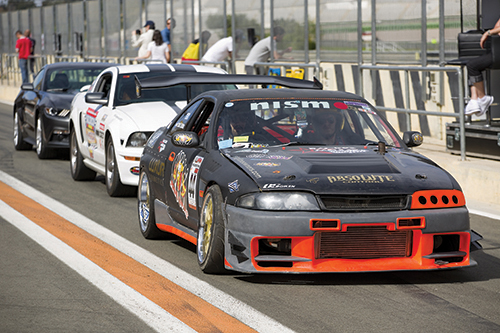◄ Back to Driving Force, Summer 2016
Congressional Legislation Will Overturn Threat to Racing Community
 If you ask the average American what they love about auto racing, you’ll find a striking similarity in the responses—speed, teamwork and precision. Since the invention of the automobile, Americans have been converting their street vehicles into race cars. Powered by passion, most professional motorsports leagues were founded on this very concept. More than a century later, the very core of this tradition is under attack.
If you ask the average American what they love about auto racing, you’ll find a striking similarity in the responses—speed, teamwork and precision. Since the invention of the automobile, Americans have been converting their street vehicles into race cars. Powered by passion, most professional motorsports leagues were founded on this very concept. More than a century later, the very core of this tradition is under attack.
Last year, the U.S. Environmental Protection Agency (EPA) issued a proposed regulation to make the act of converting a motor vehicle into a race car illegal if the emissions system is taken out of compliance from its stock configuration. This prohibition would include even those vehicles used solely at the track and never again used on public roads. If finalized, the rule would effectively prohibit the sale of certain emissions-related parts for use on converted vehicles.
Word of the EPA’s proposed rule traveled quickly as tens of thousands of motorsports participants, both amateur and professional, identified the consequences to racing vehicles that started life as a street car or motorcycle originally certified to federal emissions standards. At the core of the issue is the Clean Air Act. The EPA’s prohibition would cover all motor vehicles dating back to 1968, the year the law first took effect. The ban would not, however, impact purpose-built race cars, such as those used today in NASCAR, nor would it apply to “nonroad vehicles,” such as dirt bikes, ATVs or snowmobiles exclusively for racing. Despite this distinction in the rulemaking, the vast majority of racers begin their careers competing in a division that utilizes a modified production vehicle. This proposal would devastate the most cost-effective forms of racing.
Ralph Sheheen, managing partner and president of National Speed Sport News, has built a career around racing, which has included broadcasting racing on major television networks. “This proposed regulation from the EPA would have kept my dream from ever becoming a reality. You see, those famous racers, Mario Andretti, AJ Foyt, Richard Petty, Dale Earnhardt and so many others like them, all began their careers in vehicles that would have been outlawed according to this regulation.”
 |
|
| The RPM Act simply confirms that under the Clean Air Act it has always been legal to modify a street vehicle or motorcycle into a race vehicle used exclusively at the track, like those shown here. | |
|
|
Last December, the SEMA Action Network (SAN) filed comments challenging the EPA’s proposal. Racers and enthusiasts were also quick to react. Within 24 hours, the SAN-created White House petition denouncing the regulation gained the 100,000 signatures needed to receive a response from the administration. In fact, the Obama Administration’s “We the People Team” was flooded with nearly 170,000 signatures when the dust settled.
Due to this outcry, the SAN’s allies in the U.S. Congress introduced the Recognizing the Protection of Motorsports Act of 2016 or RPM Act (H.R. 4715/S. 2659) in both the House and Senate. “For years my constituents have been free to modify vehicles for competitive use on closed tracks without government interference,” said lead sponsor Congressman Patrick McHenry. “The RPM Act will ensure that continues.”
In an unprecedented move, seven state attorney generals sent a letter urging EPA Administrator Gina McCarthy to withdraw a proposed rule that threatens the racing industry, as well as tens of thousands of jobs throughout the United States. Among those signing the letter were Attorneys General Mike DeWine (Ohio), Patrick Morrisey (West Virginia), Leslie Rutledge (Arkansas), Luther Strange (Alabama), Jeff Landry (Louisiana), Bill Schuette (Michigan), Sam Olens (Georgia) and Adam Paul Laxalt (Nevada).
Under mounting pressure, the EPA recently announced that it will withdraw the proposed rule. However, the agency continues to assert newfound authority under the Clean Air Act to regulate street cars modified exclusively for the track. While SEMA President and CEO Chris Kersting released a statement thanking Congress for pushing EPA to withdraw its proposal, he noted that the future of racing remains under a cloud of risk—the risk of future enforcement.
Your voices are being heard! At the time of publication, nearly 120,000 letters had been sent to Congress seeking support for the RPM Act. Enthusiasts must keep the throttle pegged. Many legislators and government officials have voiced support for the RPM Act. However, many elected officials are still undecided. It is crucial that the entire racing community continues to send letters to their congressional lawmakers seeking support. If you haven’t yet contacted your legislators, visit www.sema.org/RPMAct immediately. An email account and one minute is all it takes to support the Congressional bill that will ensure that street vehicles can continue to be modified for the track. Every letter counts!
Beyond additional signatures, the SAN is also looking for additional members of Congress to co-sponsor the RPM Act. To date, the House legislation has 65 sponsors, while the Senate bill has 11. Are your elected officials among them? Visit www.semaSAN.com to find out. Given the potential impact of this rulemaking on car clubs and automotive organizations nationwide, group leaders are needed to work with Congress in passing the bill. If you are willing to send a letter on behalf of your group, notify us at san@sema.org. Respondents will receive a sample letter to be personalized and forwarded to the appropriate legislator’s office.
Q&A: Recognizing the Protection of Motorsports Act of 2016 (RPM Act)
The RPM Act simply confirms that under the Clean Air Act, it has always been legal to modify a street vehicle or motorcycle into a race vehicle used exclusively at the track.
Aren’t race cars already protected from EPA regulations?
Congress has always prohibited the EPA from regulating race cars, which are excluded from the Clean Air Act’s definition of “motor vehicle.” In July 2015, the EPA issued a proposed rule acknowledging the race car exemption but “clarifying” that it has always been illegal to convert emissions-certified vehicles into race cars. The EPA contends this is “tampering” and that a vehicle is forever a “motor vehicle” subject to the Clean Air Act, even if it is unregistered and never again driven on the highway. This proposal conflicts with congressional intent and decades of marketplace application.
Why wasn’t there more public outcry before now?
The proposed regulation was inserted into a 629-page unrelated greenhouse gas rulemaking for trucks and buses issued last July. The EPA failed to alert the public that the race car provision was included. There were no public comments on the provision until SEMA discovered it and then submitted comments on December 28, 2015.
When is the final rule scheduled to come out?
The rule is scheduled to be finalized by July 2016. However, the EPA recently announced that it will withdraw the proposed rule regarding converted race cars and certain emissions-related parts used on those vehicles.
Which Americans are affected by this rule?
The EPA’s proposed regulation would have affected Americans with any vehicle, including sports cars, sedans and hatch-backs, that started its life as a street car or motorcycle and originally certified to federal emissions standards. Federal emissions standards first took effect in 1968, so the EPA’s prohibition would cover all motor vehicles dating back to that year.
How does the RPM Act of 2016 address the problem?
While Congress has already prohibited the EPA from regulating race cars, the RPM Act will erase any doubts that the exemption applies to racing parts and vehicle modifications.
Why is it important for Congress to pass this bill?
The public needs certainty regarding how the Clean Air Act is applied, and Congress needs to confirm that it has ultimate authority. Passage of the RPM Act will end the debate and protect our nation’s racing activity now and in the future.
